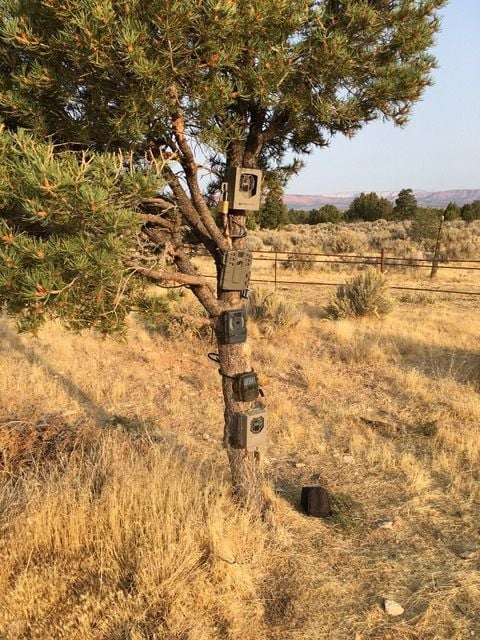As of Saturday, those seeking to bag an elk, a bear, a bighorn sheep or a host of other animals legally hunted in Arizona will no longer be able to get an edge by using trail cameras.
Violators can be subject to fines, losing their hunting rights and having to forfeit their kill.
The new rule is an extension of what hunters call “fair chase,” says Kurt Davis, chairman of the state Game and Fish Commission.
It’s based on the North American Model for Wildlife Conservation, which he calls “the bible’’ of standards and pillars of hunting.
“One of those pillars is (that) an animal has a reasonable opportunity to elude detection,’’ Davis said.
That’s why hunters can’t use drones to search for prey. And the type of remote trail cameras that can send a signal through cellphones when they spot something were outlawed by the commission for hunting use in 2018.
But, until now, it had remained legal for hunters to use nontransmitting cameras that take photos according to a set schedule, with the hunter retrieving the memory card on a regular basis.
Davis said the issue of cameras wasn’t much of a problem years ago when the devices cost upward of $300, leading only a few hunters to set them up.
“Now you can buy them in six-packs,’’ he said. “The technology, like all technology, is getting cheaper and cheaper.’’
The result is multiple cameras are being set up around water holes to see what animals gather there and when, Davis said.
Arizona has only about 3,000 water holes, all of which are mapped, meaning hunters know where they are.
“So cameras were proliferating on those water holes,’’ he said.
That created another problem. Each hunter wants to check his or her camera on a regular basis. But all that traffic scared away animals — both those that are hunted and those that are not — from the few places they could drink.
Unless their use is halted, the number of cameras would double or more within 10 years and further interrupt the patterns of the animals that use the few watering holes, Davis said.
It wasn’t just the animals that were being disturbed. He said back-to-back hunting seasons for different animals can result in one hunter’s effort to bag a deer being interrupted by others setting up cameras for a later elk hunt.
That created animosity, he said.
And then there’s the “fair chase’’ issue.
Davis said the commission sees its job as trying to maintain some sort of balance. And often, he said, that involves dealing with changes in technology.
“Our bows are better than they were 20 years ago, ‘’ he said. “Our rifles are better than they were 20 years ago, our optics are better than they were 20 years ago.” Even the clothing that hunters wear has improved.
“And we have a lot more people in the field than we did 20 years ago as the state has grown,’’ Davis continued. “So all of those things have created pressure on wildlife and on people’s outdoor experience.’’
That is why the commission decided to rebalance the hunt by banning the field cameras.
Cameras that do not transmit a real-time photo do not provide the same advantage to hunters, Davis acknowledged, as those that instantaneously send out data. But he said they still provide an edge for people who can “pattern’’ wildlife behavior.
“There are now apps and technology where you take photos and you pattern,’’ he said. “You look at time, same animal, certain times.”
Just as with everything else, the ability to analyze that data with computer programs will only get more refined, he said.
That may be only the beginning. He said there were indications entrepreneurs were setting up hundreds of cameras and then selling the images to hunters who wouldn’t even have to go out into the field and check their own cameras.
“And that begins to monetize wildlife,’’ Davis said. “And that’s a whole other issue.’’
That’s not to say there isn’t money involved in hunting. People still can hire guides to help them track and find animals. But the difference, Davis said, is that the guide has to be out in the field, “which, in the ethos of hunting, of sportsmanship, is a different standard.’’
Also important to remember, he said, is that, in Arizona, all wild animals are “public resources,’’ meaning they are the property of the state, whether for hunting with a permit or for the enjoyment of someone hiking in the woods with a camera or pair of binoculars.
“When you’re out there bird watching, say that’s what you like to do, you really don’t want to be walking into places that have 30 or 40 cameras,’’ complete with people coming in and out to check and exchange the memory cards, Davis said. “Is that really going to enhance your outdoor experience?”
The new rules do not apply to trail cameras set up for research, general photography, cattle operations or protecting private property. But anyone who uses information gathered from any of these cameras to aid in hunting operations is subject to the same punishments, even if that was not the reason the equipment was set up in the first place.
WARNING: This video contains strong language. While at a Saguaro National Park campground, hiker Tiffany Foster warded off a cougar in a tree near her tent.
Foster, who filmed and posted the encounter on YouTube, was able to contact her husband via a two-way satellite messenger and escape the Grass Shack camping site north of Vail once the mountain lion retreated.
The National Park Service alerted hikers the following day to avoid Grass Shack Campground, located in the Rincon Mountains along the Arizona National Scenic Trail, and closed the area from Dec. 3 and Dec. 12 due to mountain lion activity.
The full uncensored video can be found here. Video courtesy of Tiffany Foster.





